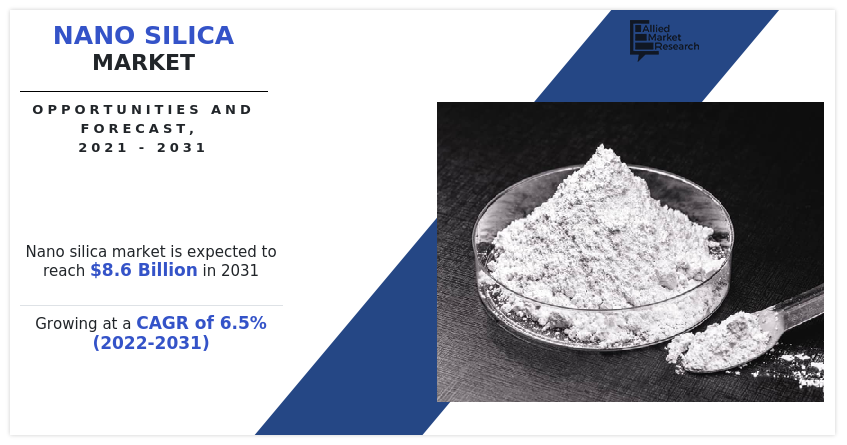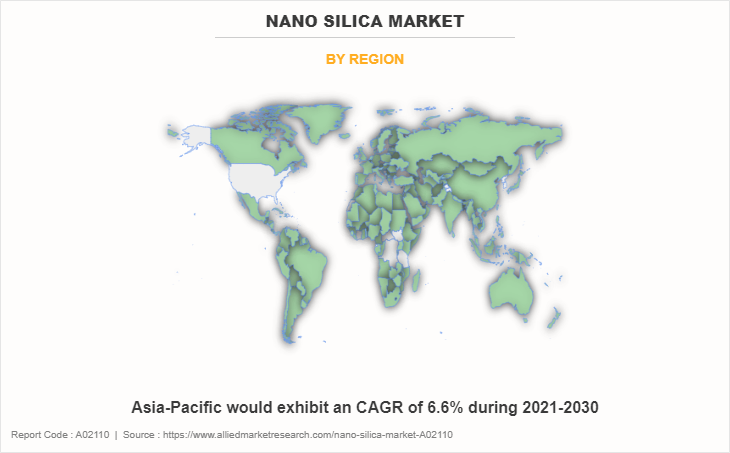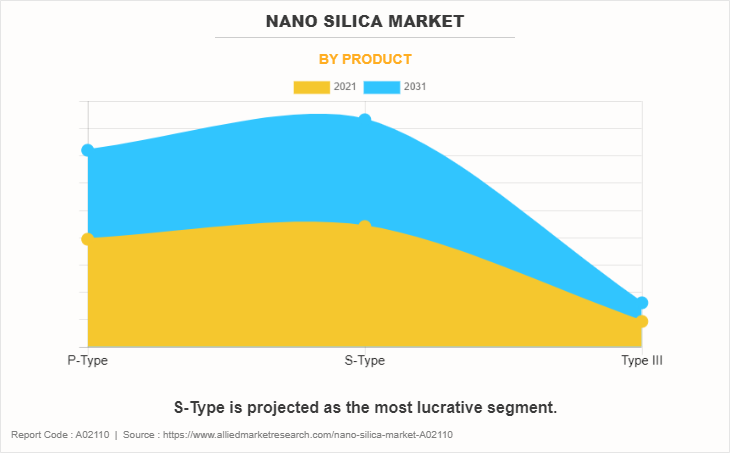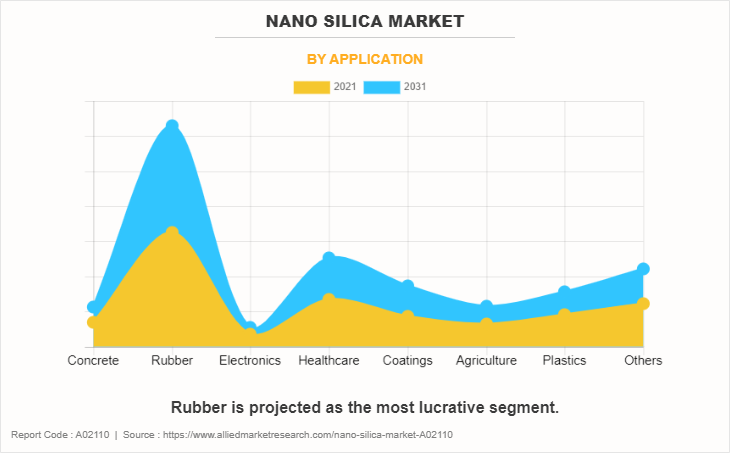Nano Silica Market Outlook - 2031
The global nano silica market size was valued at $4.6 billion in 2021, and is projected to reach $8.6 billion by 2031, growing at a CAGR of 6.5% from 2022 to 2031.
Introduction
Nano silica, also known as nanosilica, refers to a form of silicon dioxide (SiO₂) that has been engineered at the nanometer scale, typically ranging from 1 to 100 nanometers in size. Due to its extremely small particle size, nano silica exhibits unique physical and chemical properties compared to its bulk counterpart, including a high surface area, increased reactivity, and enhanced mechanical strength. These characteristics make it highly valuable in a variety of applications such as reinforcing agents in rubber and plastics, additives in concrete for improved durability and strength, and as a component in coatings, adhesives, and biomedical materials. Its versatility and performance-enhancing capabilities have driven growing interest across multiple industries, particularly in construction, electronics, and healthcare.

Market Dynamics
Nano silica is a white fluffy powder composed of high purity amorphous silica powder. Because of its small particle size, nano-SiO2 had the advantages of large specific surface area, strong surface adsorption, large surface energy, high chemical purity and good dispersion
Rising demand from the rubber industry in light of the growing automotive industry is expected to be a key factor propelling market growth. In addition, growing use of nano silica as an additive in various application segments such as concrete and rubber, and growing demand for coatings due to growth in coatings applications in the construction industry is expect to propel the growth of the market in coming years. Nano silica is being highly publicized as a promising cementitious admixture in concrete apart from paints, coatings, and rubber additives. Nano silica has the potential to leverage the mechanical and durability attributes of concrete. The ever-evolving construction industry is another key driver, which is fueling the growth of the nano silica market. As such, the construction industry is creating a demand for supplementary cementitious materials (SCMs)-like nano silica to enhance the properties of concrete.
Nano silica is gaining increased popularity for cementitious admixtures in concrete to deploy improved load-carrying capacity. Since nano silica is extremely fine, it helps to strengthen the microstructure of the cementitious matrix as a result of its pozzolanic activity. Thus, companies in the nano silica market are increasing the availability of silica nanoparticles in the construction industry where workers combine the novel element with other SCMs such as fly ash, micro silica, and risk husk ash among others. These factors are expected to drive the growth of the market during the forecast period. However, toxicity of silica fumes is expected to hamper the growth of the nano silica market during the forecast period. Furthermore, growing usage of nano silica in RNA/DNA delivery systems in innovation of vaccines is expected to provide growth opportunities for the nano silica market during the forecast period.
The global nano silica market size is segmented on the basis of product, application, and region. By product, it is analyzed across P-type, S-type, and Type III. By application, it is segmented into concrete, rubber, electronics, healthcare, coatings, agriculture, plastics, and others. Region-wise, it is studied across North America, Europe, Asia-Pacific, and LAMEA.
The major key players operating in the global nano silica market include Evonik Industries, Akzonobel N.V., E. I. DU Pont De Nemours and Company, Cabot Corporation, Nanopore Incorporated, Nanostructured & Amorphous Materials, Inc. (NANOAMOR), Fuso Chemical Co. Ltd., Wacker Chemie AG, Dow Corning Corporation, and Bee Chems.

Asia-Pacific accounted for a major market share in 2021. Rapid urbanization has led to surge in building and construction activities across the developing countries of the region such as China and India. Government of these countries have launched programs such as “Housing for All” that includes construction of homes with modern facilities for people living in urban and rural areas. Owing to this, the demand for concrete across the region is anticipated to surge considerably. Attributed to surge in demand and production of concrete, the demand for nano silica is expected to surge from construction companies during the forecast period.

The P-type segment accounted for a major share in the nano silica market in 2021. P-type nano silica is an excellent admixture for concrete as it leads to better engineering properties. It will reduce thermal cracking caused by the heat of cement hydration, improve durability to attack by sulphate and acidic waters, and increase strength. The building and construction activities are expanding at a lucrative rate across the world.
According to the U.S. Census Bureau, in February 2020, a total of 1,366,697 residential and non-residential buildings were constructed across the U.S. as compared to 1,288,951 buildings constructed in 2019, thereby registering a growth in building construction by 6.03%. In addition, according to the Federal Statistical Office (Germany), in 2020, 232,208 buildings were constructed as compared to 222,678 buildings constructed in 2019, thereby registering a growth in building construction by 4.10%. Owing to growing construction industry across the globe the demand for P-type nano silica is expected to surge significantly to be used as admixture for concrete during the forecast period.

The rubber segment accounted for a major share in the nano silica market in 2021. Nano silica, also known as silicon dioxide nanoparticles or silica nanoparticles, is the compound of silicon, which is the second most abundant element in the earth’s crust. The growing usage of nano silica as an additive in various type of rubbers including natural rubber, styrene butadiene rubber (SBR), nitrile rubber (NBR), ethylene propylene diene monomer (EPDM), ethylene acrylic rubber (AEM), and silicone rubber is increasing the demand for nano silica and thus, propelling the growth of the market. In addition, nano silica is used to increase the mechanical strength of vulcanized rubber by acting as a reinforcing agent. Also, the tensile strength of natural rubber can be increased to 14 MPa from 0.35 MPa by using nano silica. Owing to these factors, the demand for nano silica is expected to surge significantly in rubber industry during the forecast period.
Key Benefits For Stakeholders
- This report provides a quantitative analysis of the market segments, current trends, estimations, and dynamics of the nano silica market analysis from 2021 to 2031 to identify the prevailing nano silica market opportunities.
- The market research is offered along with information related to key drivers, restraints, and opportunities.
- Porter's five forces analysis highlights the potency of buyers and suppliers to enable stakeholders make profit-oriented business decisions and strengthen their supplier-buyer network.
- In-depth analysis of the nano silica market segmentation assists to determine the prevailing market opportunities.
- Major countries in each region are mapped according to their revenue contribution to the global market.
- Market player positioning facilitates benchmarking and provides a clear understanding of the present position of the market players.
- The report includes the analysis of the regional as well as global nano silica market trends, key players, market segments, application areas, and market growth strategies.
Nano Silica Market Report Highlights
| Aspects | Details |
| Market Size By 2031 | USD 8.6 billion |
| Growth Rate | CAGR of 6.5% |
| Forecast period | 2021 - 2031 |
| Report Pages | 282 |
| By Product |
|
| By Application |
|
| By Region |
|
| Key Market Players | Cabot Corporation, Normet, Wacker Chemie AG, Evonik Industries, NanoPore Incorporated, Bee Chems, Akzonobel N.V., E. I. du Pont de Nemours and Company (DuPont), Dow Corning Corporation, Fuso Chemical Co. Ltd. |
Analyst Review
According to the analyst, the suspension of public transport services and shrinking FDI investments are expected to hamper the growth of the nano silica market due to the surging COVID-19 outbreak. Nano silica is combined with gold nanoparticles to hold promising potentials in solar energy harvesting and desalinating seawater, owing to its ability to absorb light and carbon dioxide.
Nano silica is gaining increased popularity in SCMs for concrete. However, cold weather concreting is associated with challenges, such as in concrete placement for use in various construction-related applications. Hence, companies should increase their production capabilities to introduce nano silica in concrete, owing to its vigorous reactivity as a result of its ultrafine surface area.
However, toxicity of silica fumes is expected to hamper the growth of the nano silica market during the forecast period. Furthermore, growing usage of nano silica in RNA/DNA delivery systems in innovation of vaccines is expected to provide growth opportunities for the nano silica market during the forecast period.
The rising awareness about nanosilica intermediary products is expected to fuel market growth over the forecast period.
The market value of Nano Silica in the forecast period 2031 is $8.6 Billion.
Evonik Industries, Akzonobel N.V., E. I. DU Pont De Nemours and Company, Cabot Corporation, Nanopore Incorporated, Nanostructured & Amorphous Materials, Inc. (NANOAMOR), Fuso Chemical Co. Ltd., Wacker Chemie AG, Dow Corning Corporation are the top players in NanoSilica market.
Rubber, electronics, healthcare, coatings industry is projected to increase the demand for NanoSilica Market
Major factors driving the market studied are increasing demand for Nano silica in the rubber industry and rising demand from the coatings segment.
Loading Table Of Content...
Loading Research Methodology...



